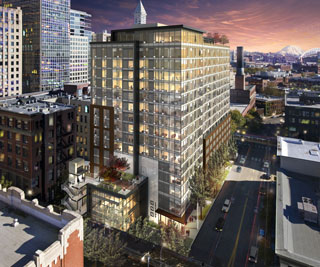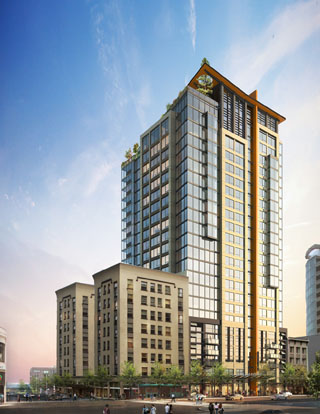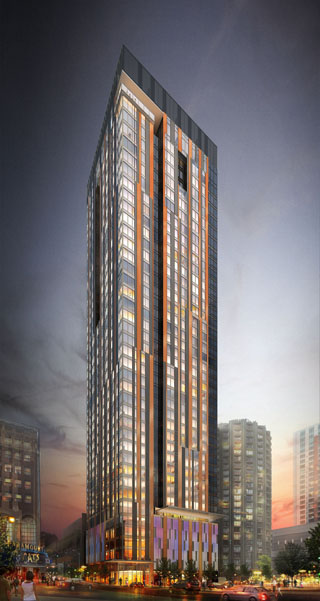|
Subscribe / Renew |
|
|
Contact Us |
|
| ► Subscribe to our Free Weekly Newsletter | |
| home | Welcome, sign in or click here to subscribe. | login |
Real Estate
| |
 |
June 28, 2012
Boom! Here come the apartments
Weber Thompson

Weber
|
Out of the ashes of the Great Recession, the apartment market has come back with a vengeance.
Some speculate that this robust apartment boom could create enough jobs to pull our economy out of the recession, in spite of continued distress in the single-family market. National market experts like Multi-Family Executive Magazine are effusive: “The multifamily apartment market is on the cusp of an historic boom.”
Seattle is poised to lead the way with one of the most promising economies in the nation.
Seattle came late to the Great Recession, but it was far from immune. When the downturn finally arrived, it hit the region hard and fast.
Today, ahead of the rest of the country, a robust Seattle recovery is in progress. The city is positioned to benefit from what could be a sustained period of growth and development.
| Apartments shoot up across town |
|
Developed by GRE and under construction, The Post will bring 208 units to the Commerce District. The 16-story tower will be finished in December.
Developed by GRE/Harbor Urban and under construction, Viktoria will bring 249 units to the Market District. The 24-story tower will be finished in September of 2013.
Illustrations by studio/216, courtesy of Weber Thompson
[enlarge]
Developed by Holland Partners, 815 Pine Street will bring 386 units to the Theatre District. The 440-foot-tall tower will be finished in January of 2015.
|
Richard Florida said it best in his recent article entitled “The Secret to Seattle’s Booming Downtown” that was published in The Atlantic Cities: “A new geography of working and living — will be our only path back to renewed economic growth, confidence and prosperity. That’s exactly the path Seattle is following.”
Seattle has become a prototype for demonstrating how the right initiatives can lure business, workers and residents back to the urban core. The efforts are paying off, and construction cranes are once again ubiquitous in downtown Seattle.
What is the catalyst for all of this development activity?
Most notable is Seattle’s focus on livability, efficient mass transit and pedestrian experience. The city’s revamped zoning code incentivizes residential use with significant development bonuses in return for public benefits and improvements to the pedestrian realm.
The new light rail and state Route 99 tunnels, the rebuilding of the seawall, and many other massive infrastructure initiatives have been a stimulus for both white and blue collar jobs. When the viaduct is demolished, it will liberate many acres of new public lands, opening the door to substantial waterfront development that will reconnect the city to Elliott Bay.
Amazon’s new campus in the Denny Triangle is a tremendous catalyst, with the promise of infusing 12,000 high-paid technology workers into the heart of the city. Not far away, the Gates Foundation, University of Washington, and South Lake Union’s 446-acre technology and bio-medical campus continue to attract world-class research and development, not to mention education.
The growing cruise ship and convention industries are set to double capacity in a matter of years, bringing in significant out-of-state dollars.
Big box retailers like Target are again moving into the city center. A third sports stadium is stirring excitement. And for a bit of levity, the waterfront sports a brand new Canary Wharf-style Ferris wheel that reaches for the sky.
In response to all of this activity, local and national developers are rushing to provide housing in anticipation of thousands of new downtown workers — the majority of whom will want to live, work and play in the city.
3 reasons Seattle’s a good bet
1. Youth magnet
Seattle was awarded “first place in the nation” when The Wall Street Journal enlisted a panel of experts to predict the “Top Ten Youth Magnet Cities” in 2010. These cities attract college-educated young people seeking to launch a new career.
How did these panelists come to the conclusion that Seattle deserved the top ranking?
• Panelist Ross DeVol, director of regional economics at Milken Institute, said: “Today’s recession-scarred young people are placing greater emphasis on where high-quality, high-paying jobs are created. Seattle’s technology workers represent a growing workforce that is just slightly smaller than Silicon Valley’s.”
• Panelist Dr. Richard Florida said: “Seattle is a high-tech/lifestyle mecca, offering transit, walkability, and central location.”
• Panelist William Frey, a senior fellow at the Brookings Institution, said: “None of the other cities could match Seattle’s combination of a diverse high-tech sector, cultural life, access to rugged natural terrain and a strong university presence.”
Seattle has become one of the most desirable cities for an ambitious young technology workforce. These youthful and inspired workers are embracing urban living in a way that no other generation has.
The positive effects of this “talent-attraction” cannot be understated. A rapid population increase comprised of the best minds and the most highly motivated young people improves the quality of the labor market, which attracts business. A youthful migration to Seattle will continue to be an immensely powerful economic stimulus for the region into the future.
2. Innovative knowledge cluster
A recent study published by the Journal of Urban Studies states that Seattle (along with Austin, Texas) is: “An innovating region, with high knowledge in information technology, arts, commerce and engineering.” The article goes on to discuss how these regions bring substantially more stimulus to regional growth economics and development than others.
These knowledge clusters attract research-and-development people — highly creative and ambitious minds looking to realize their full creative and economic potential by locating in a place that feeds the pace of technological evolution. This is one of many reasons that Seattle continues to incubate high-tech companies like Microsoft, Amazon, Starbucks, Adobe, Real Networks, F5, Cray Computers, Zillow, Redfin and Corbis.
Seattle enjoys a reputation for being home to a lot of brainy people, and for being a city of ideas. This region is a hotbed for technological innovation, and one of the most prolific for producing advanced technology patents in the nation.
3. “Crackling with creative energy”
Seattle consistently ranks near the top of many national surveys. Kiplinger’s Personal Finance placed Seattle second on the list of “10 Best Cities for the Next Decade” when it comes to smart people, great ideas and collaboration. It said: “When governments, universities and business communities work together, the economic vitality is impressive. Home to a well-educated workforce and a world-class research university, uber-innovators Microsoft, Amazon and Boeing, and a host of risk-taking, garage-tinkering entrepreneurs, Seattle crackles with creative energy.”
Housing shortage or overbuilt?
The rental housing market has only just begun a new cycle, but the naysayers are already suggesting that we are on our way to being over built. What they fail to see is the astonishing lack of supply during the last few years, the challenge of local barriers to entry and the difficulty of funding large projects in a recovering market. The time that it takes to secure entitlements also contributes to a constriction of the supply line at a time when demand is ramping up.
Some experts suggest that we could be facing a rental housing shortage and double-digit rent increases due to increased demand and constrained supply:
• The Harvard Joint Center for Housing Studies says in its latest report: “Renter household growth should remain strong for some time. But even as the economic recovery gains traction and homeownership rates level off, rental demand should get a boost from higher household formations among the echo boomers.”
• Timothy Naughton, CEO of AvalonBay, says his company is focused on high-demand coastal growth markets, like Seattle. “We do believe there is a significant amount of pent-up demand,” he said. “There are over 2 million households that haven’t yet been formed.”
• Brian O’Connor of O’Connor Consulting says: “A perfect storm has been brewing for the rental housing market in Seattle, in a good way. This apartment cycle will prove to be the strongest in the last 20 years, and possibly one of the most sustained on record.”
Nation of renters?
Gen Y will determine the fate of the housing market. These 80 million people between the ages of 20 and 32 are prime rental market targets. They do not have the same desire as their predecessors for owning their own home, and many will give up car ownership to live in city centers.
Psychographic experts believe that we may be witnessing a long-term shift that will favor renting over buying. Four million Americans lost their homes to foreclosure or decided to rent as a lifestyle choice in the wake of the recession. The ratio of homeownership to renters is favoring the latter, and may never return to pre-recession “norms,” thanks to the recession carnage and a new mind-set.
The Urban Land Institute says that “with a 30 percent unemployment rate and an average $23,000 post-college debt, Generation Y is not able to save for a down payment. Their parents, struggling to recover themselves, can’t help. Meanwhile, many would-be buyer/borrowers no longer qualify for refinancing due to tighter lending requirements.”
For now, Gen Y is a generation of renters. Eventually, a portion of this generation will succumb to the lure of homeownership, but many will choose to rent permanently.
Blaine Weber, AIA, is a founding partner of Weber Thompson, a highly diversified, multi-disciplinary, Seattle-based design firm specializing in housing, hospitality, commercial and retail.
Other Stories:
- TOD projects not always the perfect solution
- Is there room for young families in the city?
- Is it too late to invest in apartments?
- Mixed-use construction becomes a science
- Urban agriculture takes root in Seattle
- Don’t be afraid of large, long, sloping sites
- Multifamily developers cater to the Gen Y crowd
- The key to successful TODs lies in taller buildings
- Modular apartment buildings on the rise





